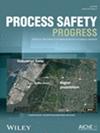后果分析、防护层分析、领结分析作为预防事故的策略
IF 1
4区 工程技术
Q4 ENGINEERING, CHEMICAL
引用次数: 0
摘要
摘要:本文讨论了一些事故,并运用后果分析、保护层分析(LOPA)和蝴蝶结法建立了安全控制过程的最佳方法,以避免因过充而失去安全壳。考虑到目前的调查,对四起事故及其后果进行了审查。对12种产品进行了后果分析,以演示如何确定系统的保护水平,以减少由于溢流而造成安全壳损失的可能性。最后,使用LOPA和蝴蝶结来确保系统在可接受的风险承受水平上有足够的保护,并在其整个生命周期中得到正确的维护。分析表明,需要一个安全完整性等级为2的独立保护层,以达到10 - 4 /年的风险承受能力要求,这是一个已知且被广泛接受的事故有可能导致死亡的频率。此外,还进行了退化因素和控制的研究,以提高干扰顶级事件频率的所有组件的可靠性。这将提高整个系统生命周期的过程安全性,并且结果也将用于保障审核。本文章由计算机程序翻译,如有差异,请以英文原文为准。
Consequence analysis, layer of protection analysis, and bow‐tie as strategies to prevent accidents
Abstract This article discusses some accidents and uses consequence analysis as well as layer of protection analysis (LOPA) and bow‐tie to establish the best approach for safely controlling the process to avoid loss of containment due to overfilling. Four accidents and their aftermaths are examined, considering current investigations. Consequence analysis was used with 12 products to demonstrate how to determine the level of protection of the systems to reduce the likelihood of containment loss due to overflow. Finally, LOPA and bow‐tie were used to ensure that the systems have adequate protection at an acceptable level of risk tolerance and will be correctly maintained throughout their life cycle. The analyses indicated that an independent layer of protection with safety integrity level 2 was required to achieve the risk tolerance requirement of <10 −4 /year, which is a known and widely accepted frequency when an accident has the potential to result in a fatality. Furthermore, a study of degradation factors and controls was performed to enhance the reliability of all the components that interfere with the frequency of the top event. This will improve process safety throughout the system's lifecycle, and the results will also be input for safeguards audits.
求助全文
通过发布文献求助,成功后即可免费获取论文全文。
去求助
来源期刊

Process Safety Progress
工程技术-工程:化工
CiteScore
2.20
自引率
10.00%
发文量
99
审稿时长
6-12 weeks
期刊介绍:
Process Safety Progress covers process safety for engineering professionals. It addresses such topics as incident investigations/case histories, hazardous chemicals management, hazardous leaks prevention, risk assessment, process hazards evaluation, industrial hygiene, fire and explosion analysis, preventive maintenance, vapor cloud dispersion, and regulatory compliance, training, education, and other areas in process safety and loss prevention, including emerging concerns like plant and/or process security. Papers from the annual Loss Prevention Symposium and other AIChE safety conferences are automatically considered for publication, but unsolicited papers, particularly those addressing process safety issues in emerging technologies and industries are encouraged and evaluated equally.
 求助内容:
求助内容: 应助结果提醒方式:
应助结果提醒方式:


